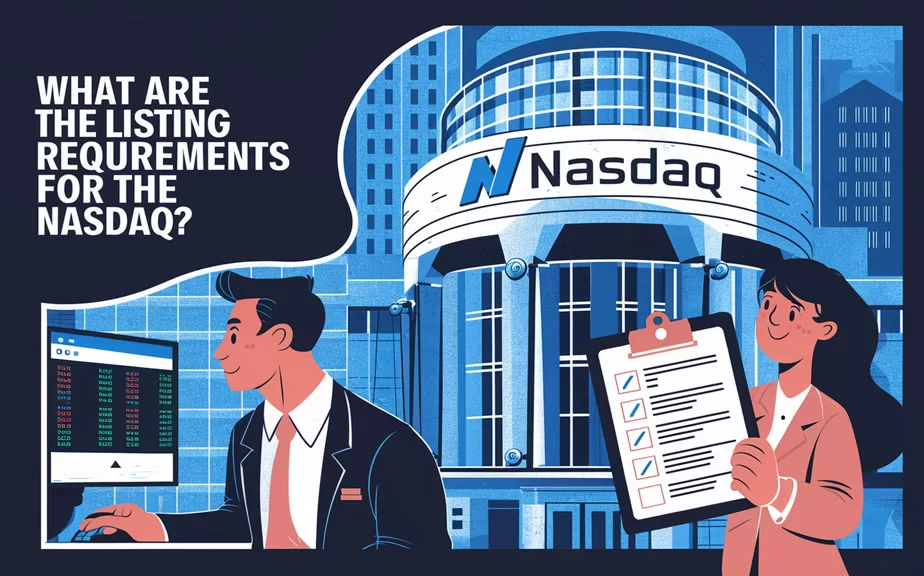Major stock exchanges, like the NASDAQ, are exclusive clubs. Their reputations rest on the quality of companies they trade. Therefore, the NASDAQ won’t allow just any company to be listed. Only companies with a solid history and top-notch management are considered. The NASDAQ has four sets of listing requirements, and each company must meet at least one of these sets in addition to the main rules for all companies.

Key Takeaways
- Major stock exchanges, like the NASDAQ, are selective about the companies they list.
- The NASDAQ has four sets of listing requirements.
- Companies must meet at least one of these four sets and adhere to the main rules for all companies.
- Each set of requirements includes specific financial and operational criteria.
- Companies must maintain these standards to avoid delisting from the NASDAQ.
Listing Requirements for All Companies
Each listing firm must adhere to U.S. Securities and Exchange Commission (SEC) Marketplace Rules for NASDAQ listings, including corporate governance rules 4350, 4351, and 4360.
To be listed:
- The regular bid price of shares must be at least $4.00. However, alternatives of $3.00 or $2.00 may apply under certain conditions.
- There must be at least three (or four, depending on criteria) market makers for the stock.
- Companies need a minimum of 1,250,000 publicly traded shares outstanding, excluding those held by officers, directors, or any beneficial owners of more than 10% of the company.
- Companies must have at least 450 round lot shareholders, 2,200 total shareholders, or 550 total shareholders with 1.1 million average trading volume over the past 12 months.
To stay listed, companies must continue meeting these requirements or risk delisting from the NASDAQ exchange.
Financial Standards for NASDAQ Listing
There are four sets of financial standards a company can meet to qualify for NASDAQ listing:
Standard No. 1: Earnings
- Aggregate pre-tax earnings in the prior three years must be at least $11 million.
- At least $2.2 million of this must be from the previous two years.
- No single year in the prior three years can have a net loss.
Standard No. 2: Capitalization With Cash Flow
- Minimum aggregate cash flow of $27.5 million over the past three fiscal years.
- No negative cash flow in any of those years.
- Average market capitalization over the prior 12 months must be at least $550 million.
- Revenues in the previous fiscal year must be at least $110 million.
Standard No. 3: Capitalization With Revenue
- Companies can bypass the cash flow requirement if their average market capitalization over the past 12 months is at least $850 million.
- Revenues over the prior fiscal year must be at least $90 million.
Standard No. 4: Assets With Equity
- Companies can eliminate the cash flow and revenue requirements and lower their market capitalization requirement to $160 million.
- Total assets must be at least $80 million.
- Stockholders’ equity must be at least $55 million.
NASDAQ Listing Fees
Depending on the types of securities listed and the company’s size, an application fee ranging from $5,000 to $25,000 is required. Additionally, an entry fee ranging from $50,000 to $270,000 is necessary. Fees for the number of shares listed can range from $100,000 to $150,000. There are also several other fees, including annual listing fees and additional charges for smaller companies, record-keeping, and issuing additional shares.
Current NASDAQ Listings
As of July 2023, over 3,300 companies are listed on the NASDAQ, which has the highest trading volume of any U.S. exchange, with approximately 1.8 billion trades per day.
Famous Companies on NASDAQ
Many well-known companies, particularly in the tech sector, are listed on the NASDAQ. These include Apple, Microsoft, Meta (Facebook), Tesla, Amazon, Intel, Netflix, and Alphabet (Google). Famous non-tech companies listed include Costco, PepsiCo, and Starbucks.
Dual Listing
Yes, companies can be listed on more than one exchange, known as dual listing. To do so, a company must meet the listing requirements of each exchange. However, it’s uncommon for companies to pursue this option.
The Bottom Line
A company has four ways to get listed on the NASDAQ, depending on its underlying fundamentals. If a company does not meet specific criteria, such as the operating income minimum, it can compensate with larger minimum amounts in another area, like revenue. This helps maintain the quality of companies listed on the exchange. Once listed, companies must continue to meet NASDAQ’s standards to avoid delisting, which can occur if they fall below the minimum required share price or market capitalization.
Willie McClellan is a financial analyst and personal finance expert with over 15 years of industry experience. Holding a Master’s degree in Finance from the University of Chicago, Willie has worked with top investment firms, providing insights on market trends and investment strategies. He is passionate about financial education and regularly contributes to leading financial blogs and magazines. When not working, Willie enjoys hiking and spending time with his family.



